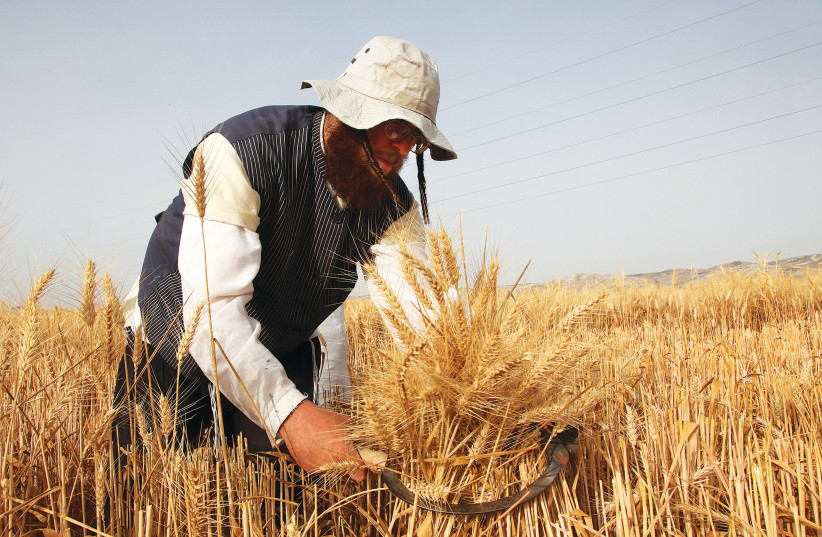The many faces of Shavuot harvest, revelation, and tradition
The Torah is described as the Tree of Life, and there is a legend that Mount Sinai once was a “green mountain” covered with trees and shrubs.

Shavuot, like the other two biblical pilgrimage festivals of Passover and Sukkot, is an agricultural holiday. It is also known as Chag HaKatzir (Harvest Festival), occurring in late spring, 50 days after the beginning of Passover.
The name Shavuot means “weeks.” Another biblical name for Shavuot is Yom HaBikkurim (Day of the First Fruits), referring to the joyful pilgrimage to Jerusalem, where the Israelites offered up baskets of their first ripe fruits and bread baked from the newly harvested wheat.
A remarkable transformation took place in rabbinic times, when Shavuot became the holiday for observing the anniversary of the giving of the Torah at Mount Sinai (Pes. 68b), known as Zeman Matan Torateinu (“the time of the giving of our Torah”). Consequently, the Torah reading for the day includes a recitation of the Ten Commandments (Exodus 20:2-14), originally read daily in the Temple.
Ezekiel’s mystical vision
After the destruction of the Temple, the rabbis (Ber. 12a) discouraged its recitation in the synagogue, lest sectarians argue that only these commandments, rather than the entire Torah, were given to Moses on Mount Sinai. The haftarah reading for the first day is Ezekiel’s stunning mystical vision of the Divine Chariot (Merkavah) (1:1-28; 3:12).
Another view is that staying up all night on the eve of Shavuot atones for the behavior of those Israelites experiencing the Revelation at Sinai who slept late that morning and had to be awakened by Moses.
In the Diaspora, some communities stay up late on the second night of Shavuot to recite the entire Book of Psalms in honor of its author, King David, who was born and died on Shavuot.
Sephardi communities often read a special ketubah (marriage contract) in front of the Holy Ark, symbolically celebrating the marriage between God and Israel at Mount Sinai. A Sephardi tradition is to recite a piyyut (liturgical poem) by Ibn Gabirol called “Azharot,” which lists the 613 commandments in the Torah.
In the synagogue, the congregation reads the Book of Ruth, a story that takes place at harvest time (2:23). A convert, Ruth accepted the Torah just the Israelites did at Mount Sinai. Ruth was the great-grandmother of King David (4:7), who is closely associated with the festival.
On Shavuot, flowers and plants adorn homes and synagogues. The Torah is described as the Tree of Life, and there is a legend that Mount Sinai once was a “green mountain” covered with trees and shrubs, as implied by the phrase “neither let the flocks nor herds graze” (Exodus 34:3). The rabbis termed Shavuot as the “Day of Judgment” for the fruit of the trees (RH 1:2).
Greenery is also symbolic of the reeds in which the infant Moses was hidden when he was rescued on the 6th of Sivan, the day of Shavuot.
A fragrant rose
Some communities adorn the Torah scrolls with roses because, according to a midrashic interpretation of the “Song of Songs,” Israel is likened to the one fragrant rose among the thorns of the world, the only nation willing to accept the Torah.Shavuot meals emphasize dairy foods, recalling the description of the Promised Land as “flowing with milk and honey” (Exodus 3:8) and because the Israelites had not yet implemented the newly given kosher dietary law of separating milk and meat. Among Ashkenazim, blintzes – thin crepes filled with cheese – are popular.
Some communities eat triangular dumplings (kreplach) stuffed with cheese. A triangle because the Torah is composed of three parts (Five Books of Moses, Prophets, and Writings); it was given to a people divided into three groups (Kohanim, Levites, and Israelites); and it was given on the third month through Moses, who was the third child of his parents.
It is traditional to inaugurate the education of a Jewish child on Shavuot, the season of the giving of the Torah. In the Middle Ages, a child was introduced to the Hebrew aleph-bet, and then was given cakes, honey, and candies so that “the Torah might be sweet on his lips.” ■
Ronald Eisenberg is professor of radiology at Harvard Medical School and has a doctoral degree in Jewish studies.






